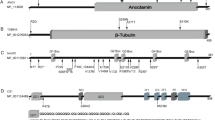Abstract
Dystonia musculorum is a hereditary neurodegenerative disease in mice that affects sensory neurons. In an effort to clone the gene responsible for this disorder, we have assembled a genomic contig spanning 75 kb of the dystonia musculorum (dt) locus. Within this genomic contig, we have identified a small restriction fragment that shows evolutionary conservation to rat, hamster, rabbit, and human genomic DNA. Using this mouse sequence, we have cloned the conserved human genomic fragment. Sequence analysis of the mouse and human genomic fragments revealed that they share a sequence similarity of 82% over 175 bp. A panel of human/rodent somatic cell hybrids was used to map the human genomic sequence to Chromosome (chr) 6, and high-resolution in situ hybridization (FISH) allowed it to be sublocalized to 6p12. The human homolog of the mouse Bpag1 gene, a gene tightly linked to the mouse dt gene, also maps to Chr 6. Thus this comparative mapping reveals a new region of conserved synteny between the chromosomes of mouse and human. Mapping the human homolog of the mouse dt gene enables us to initiate linkage studies to identify neurodegenerative disorders that may be caused by mutations in this gene.
Similar content being viewed by others
References
Brown, A., Copeland, N.G., Gilbert, D.J., Jenkins, N.A., Rossant, J., Kothary, R. (1994). The genomic structure of an insertional mutation in the dystonia musculorum locus. Genomics, in press.
Copeland, N.G., Gilbert, D.J., Li, K., Sawamura, D., Giudice, G.J., Chu, M.-L., Jenkins, N.G., Uitto, J. (1993). Chromosomal localization of mouse bullous pemphigoid antigens, BPAG1 and BPAG2: identification of a new region of homology between mouse and human chromosomes. Genomics 15, 180–181.
Drouin, R., Lemieux, N., Richer, C.L. (1988). High resolution R-banding at the 1250 band level. I. Technical considerations on cell synchronization and R-banding (RHG and RBG). Cytobios 56, 107–125
Drwinga, H.L., Toji, L.H., Kim, C.H., Greene, A.E., Mulivor, R.A. (1993). NIGMS human/rodent somatic cell hybrid mapping panels 1 and 2. Genomics 16, 311–314.
Dubois, B.L., Naylor, S.L. (1993). Characterization of NIGMS human/rodent somatic cell hybrid mapping panel 2 by PCR. Genomics 16, 315–319.
Feinberg, A.P., Vogelstein, B. (1983). A technique for radiolabeling DNA restriction endonuclease fragments to high specific activity. Anal. Biochem. 132, 6–13.
Kothary, R., Clapoff, S., Brown, A., Campbeli, R., Peterson, A., Rosant, J. (1988) A transgene containing lacZ inserted into the dystonia locus is expressed in neural tube. Nature 335, 435–437.
Lemieux, N., Dutrillaux, B., Viegas-Péquignot, E., (1992) Simultaneous R- or G-banding and fluorescence in situ hybridization of small single-copy genes: a very simple method. Cytogenet. Cell Genet. 59, 311–312.
O'Brien, S.J., Womack, J.E., Lyons, L.A., Moore, K.J., Jenkins, N.A., Copeland, N.G. (1993). Anchored reference loci for comparative genome mapping in mammals. Nature Genet. 3, 103–112.
Sambrook, J., Fritsch, E.F., Maniatis, T. (1989). Molecular Cloning: A Laboratory Manual. (Cold Spring Harbor, N.Y.: Cold Spring Harbor Laboratory Press).
Sawamura, D., Nomura, K., Sugita, Y., Mattei, M.-G., Chu, M.-L., Knowlton, R., Uitto, J. (1990). Bullous Pemphigoid Antigen (BPAG1): cDNA cloning and mapping of the gene to the short arm of human chromosome 6. Genomics 8, 722–726.
Author information
Authors and Affiliations
Rights and permissions
About this article
Cite this article
Brown, A., Lemieux, N., Rossant, J. et al. Human homolog of a mouse sequence from the dystonia musculorum locus is on Chromosome 6p12. Mammalian Genome 5, 434–437 (1994). https://doi.org/10.1007/BF00357004
Received:
Accepted:
Issue Date:
DOI: https://doi.org/10.1007/BF00357004




